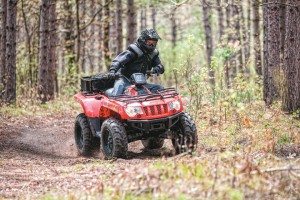Arctic Cat keeps firm foothold on ATV market
Sales, R&D spend both on the rise
Arctic Cat’s Wildcat has been the company’s off-road golden child ever since its release in 2011. After all, it was Arctic Cat’s first foray into the sport side-by-side segment, and the first challenger to Polaris’ RZR. But while Arctic Cat has spent much of its time, R&D money and energy on Wildcat and its many iterations, the OEM hasn’t lost sight of its ATV product.
Despite a large number of former-ATV riders turning to side-by-sides, Arctic Cat chairman and CEO Claude Jordan still sees a strong market for those who would rather straddle a seat and use handlebars rather than sit up straight behind a steering wheel.
“There are certain things you can do with an ATV that you just can’t do with a side-by-side,” Jordan told Powersports Business during a springtime meeting at the company’s offices in Plymouth, Minn. “It’s smaller; it’s easier to get around. Even if it’s something like plowing a driveway, if you’ve got a small driveway, it’s hard to get a side-by-side in there and do any reasonable work.”
Another factor still drawing customers to ATVs is price. Whereas Arctic Cat’s side-by-sides start at $10,999, its ATVs start at $4,299 and many can be had for under $8,000.
“There’s always going to be a need, whether it’s farmers or ranchers or recreational riding. People just like having that single-seat type of unit,” Jordan said.
Though ATV sales aren’t what they were in pre-recession times in part because of the economy and of course due to the explosion of the side-by-side market, Arctic Cat still expects the industry to see single-digit sales increases in that segment as certain demographics stick with ATVs.
“I think you’re going to get steady growth there in terms of units, but you’re not going to see the growth that you’re going to see in side-by-side because over a third of the customers buying an ATV considered buying a side-by-side at the same time. So you are seeing more and more people transition away from the ATV to a side-by-side,” Jordan said.
Off-road business increasing
Arctic Cat’s ATV/side-by-side sales increase of 12 percent in the Dec. 31-ending third fiscal quarter was credited mostly to the Wildcat X Limited and the Wildcat 4X. However, ATVs also played a role in that improvement. The star of the lineup has been the company’s mid-size 500 model.

“The ATV 500 value model has been a huge hit for us,” Jordan reported. “That’s the one where a couple of us have a model out there that we’re competing against, and so Polaris, for example, used to have a 500 carb, did away with that, came out with the 570 EFI. We countered with a 500 EFI and priced below it, and so we’re not selling anywhere near what Polaris does … but on a percentage growth basis, that model has probably jumped 800 percent in year-over-year growth, so significant growth there.”
Other ATVs have also seen success.
“I would say across the board, our 700 series continues to do very well,” Jordan said. “Our 400/450s, they continue to do well. In fact, actually, any of those smaller ones, the 400/450/500, because the market is so big, that’s truly the largest segment out there, but they continue to do well also.”
To keep sales in positive territory, Arctic Cat will continue innovating on the ATV side, even as it expands its side-by-side lineup. The company has focused heavily on R&D as of late and increased its research and development investment by 20 percent through its fiscal third quarter. Jordan says innovation is the best way to keep customers interested year after year.
“You have to invest in R&D, whether it’s as simple as re-skinning an ATV, so the customer can get excited about something — give them a reason to come back in and buy it. Or sometimes you just want to go with a brand new chassis or a brand new engine, and if you’re going to do that, you might as well go ahead and re-skin it again,” Jordan said. “So I know that when we look at our product planning and our product development, we’re very excited with what’s going on on the ATV side.”




